Conservation Work
ICI, Kolkata has a dedicated team of trained and experienced conservators who carrying out conservation of all types of heritage objects like manuscripts, sculptures, paintings on canvas, paper, wood, miniature paintings, lithographs, archival materials including photographs, textiles, murals, ethnological objects, animal skins, stone, metal etc. as well as wall paintings. Besides, other art objects holding historical and cultural significance are preserved for posterity.
The fiber glass painting by Anjali Ela Menon (Metro railway), the Royal Coat of Arms at the Raj Bhavan, Oil on Canvas (The Last supper), St.John Church, Kolkata are some of the more unique items restored by the centre.
Some other Major Assignments Are
Restoration of
- Manuscripts, Wooden masks, Mak-Dhog Monastery, Aloobari, Darjeeling, west Bengal
- Paintings,books, manuscripts and other objects related to Sir Jagadish Chandra Bose in Sir. J.C. Bose Museum, Acharya Bhavan, Kolkata.
- Paintings and paper manuscriptsand other objects related to Netaji Subash Bose in Netaji Museum, Netaji Bhavan, Kolkata.
- Paintings and Photographs of Vestry Room of St. John’s Church, Kolkata
- Burial Registers of St. Andrew’s Church, Kolkata
- Paintings and Photographs of Royal Calcutta Turf Club (RCTC), Kolkata
- Paintings of Bengal Chamber of Commerce & Industry, Kolkata
- Paintings of Bengal Chamber of Commerce, Kolkata.
- Collections of paintings of Artist Hemen Mazumdar and the marble grandfather clock in Chowdhury’s Estates’ Pvt. Ltd., Kolkata
- Bronze statues, Flagstaff house. (The residence of West Bengal Governor in Barrrackpore), Kolkata
- Books, manuscripts, maps, medal, Fort William, Eastern Command, Kolkata
- Maps of Kolkata, Port Trust, Kolkata
- Rail Time Table, Eastern Railway, Kolkata
- Certificates of Dwarkanath Tagore, Rabindra Bharati Museum, Kolkata
CASE STUDY
INTRODUCTION
The oil painting depicts the image of the famous story from the Bible named ‘Last Supper’ where Lord Jesus is sitting in front of a dining table surrounded by his 11 disciples. The painting was created by the famous German Painter Johann Zoffany who is considered one of the founding artists of the British School of the 18th Century. The painting was depicted in 1787, signature and the thumb impression along with the date located right lower portion of the painting: 175cm from upper tacking edge, 57cm from lower tacking edge. The artwork was donated by the artist to the church at the time of consecration in 1787.The Size of the painting was 304cm x 240cm.
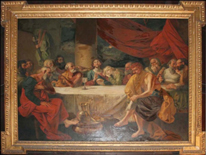
Before Restoration (front view)
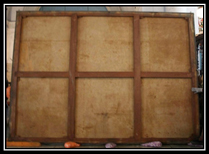
Before Restoration (back view)
CONSERVATION STATUS
After visual examination of the painting, we found that the painting was base on joined of two pieces of canvas. The painting was suffering from aging cracks, loss of paint layer, flaking, abrasion, warping, stains, dust and dirt etc. The painting was previously several times restored with at least 2 major treatment impacts (one description of decayed condition should be documented to date back to 1888).
Previous Restoration
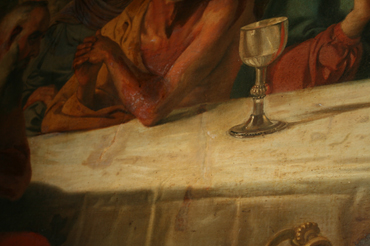
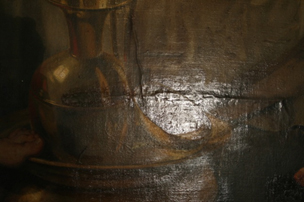
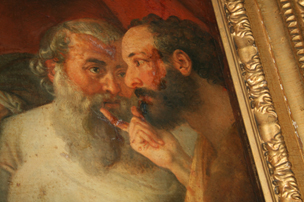
The painting was lined on a secondary canvas. Protective varnish layer was applied on painting surface. The varnish became oxidized. The transparency was from moderate to opaque, so some of the portions became dark and patchy. Most of the infill sections were unevenly leveled and these were filled by various unknown putty media which were extremely oversized, hard consistency and cracks. Over painted and tinted varnish layers are covering huge parts of the original image.
CONSERVATION TREATMENT
The large painting was removing from the wooden wall by using hand pulling crane due to heavy weight. Then the painting was dismantled and dry brushed.

Removal the painting from the wall
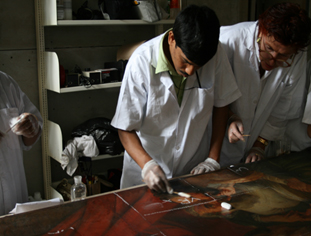
Removal of the varnish
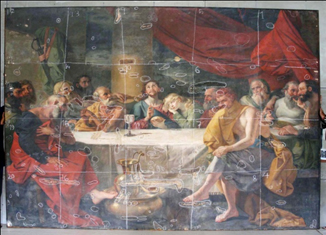
After removal of varnish area-70 nos.
of in filled area was find out
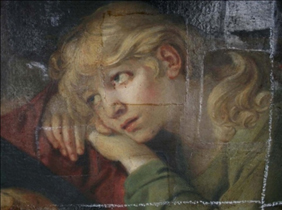
Thick layer of varnish was removed partially
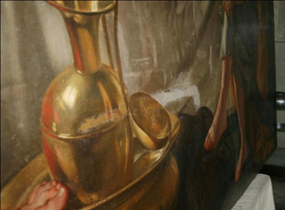
Reintegration of colour
The supper facial dust and dirt was cleaning with soft eraser and in suitable solvents. Then flaked paint layer was consolidated by applying a suitable consolidates. The tinted varnish layer was removed and seen 70nos of in filled area.
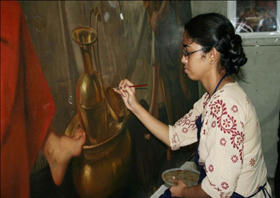
Reintegration of colour
The previous in filled sections were removed by mechanically. The old infill area was cleaned and refill in suitable infill material. Due to the taking ages of the canvas was very weak, so the edges were strengthen by strip lining of canvas. The infill was leveled and reintegration of color was done. The painting was re-stretched on cleaned stretcher with support of loose lining. At last a layer of protective coat was applied.
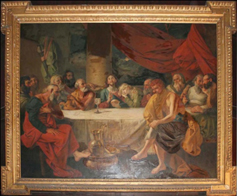
Before Restoration
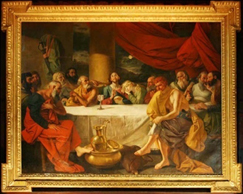
After Restoration
CONCLUSIONS
The primary aim of the conservation intervention was that of bringing the work back to a stable and original position.









